Ajanta's Buddhist Caves, and Getting There
Today we set out by bus to reach another set of caves, this time at Ajanta, about 68 miles northeast of Aurangabad. Along the way we see some vignettes of city life, village life and rural life in the state of Maharashtra, and capture a few with camera from the bus window.
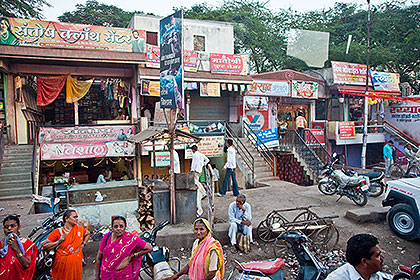
City street.
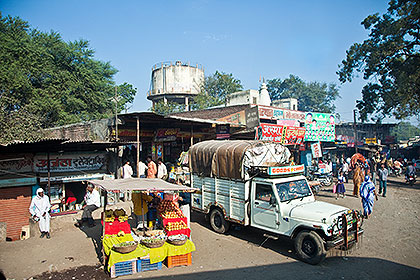
Fruit market.

Restaurant.
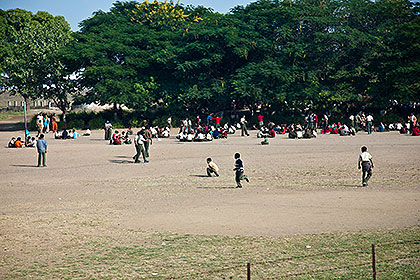
Ball field.
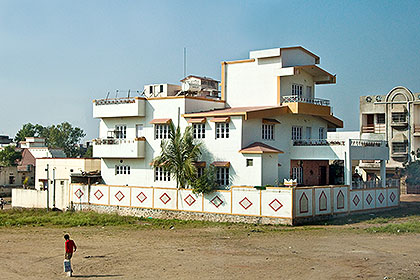
Fancy house.

Farm house.
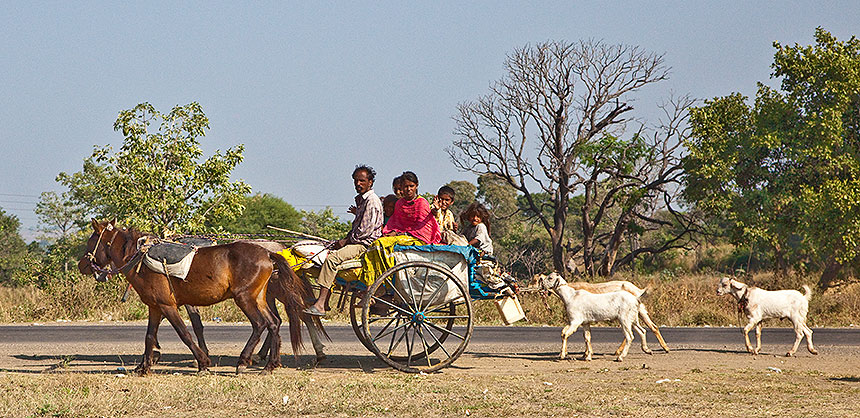
Farm family.
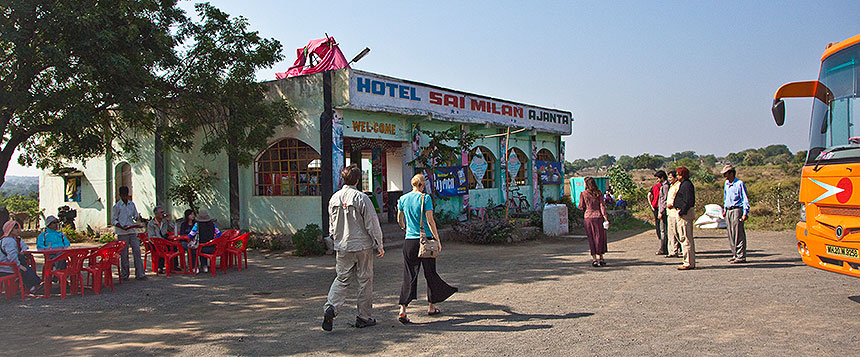
Nearing Ajanta we make a rest stop here, next to a field of cotton.
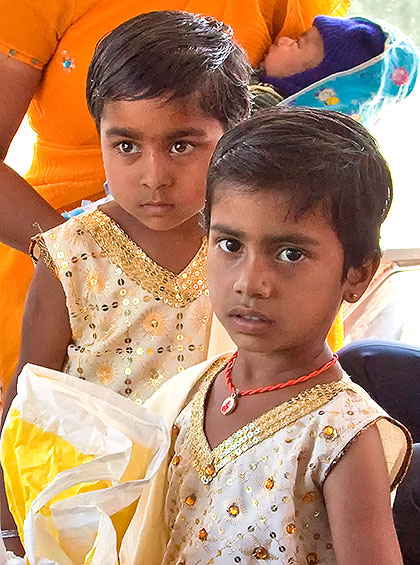
We take a shuttle bus to the caves, and are joined by this family.
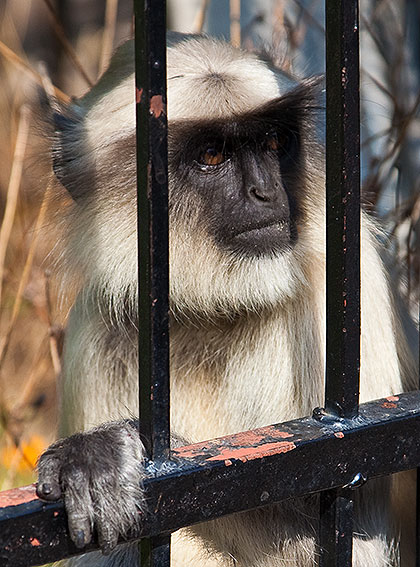
At the entrance to the caves this monkey surveys us blankly.
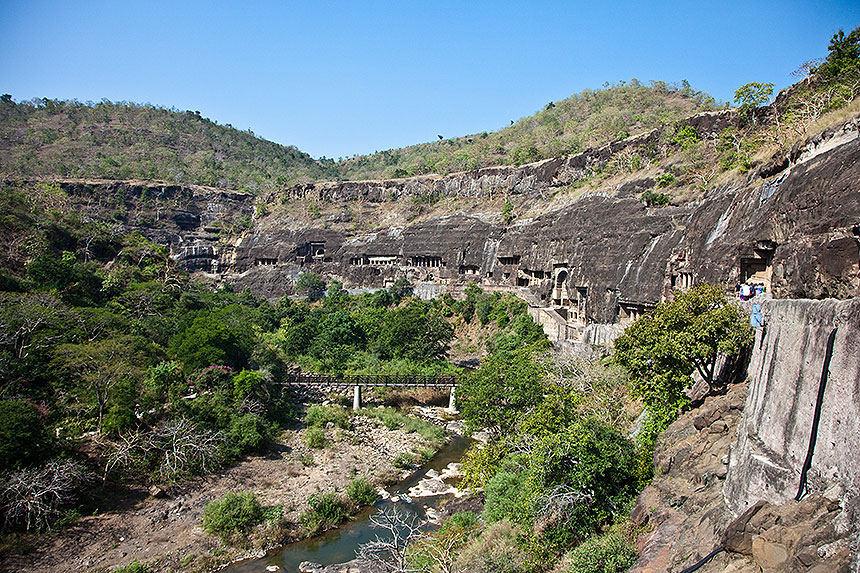
The 30 Ajanta caves are hewn from the rock of an escarpment cut by a horseshoe bend of the Waghora river. They are much older than the caves at Ellora; some of these date from as far back as the 2nd century BC. All of them are Buddhist, though not all of the same Buddhist sect. The painted art here is tempera (painted on plaster applied to the cave walls), making it inherently more fragile than rock sculptures, and the paintings clearly show a lot of accumulated damage. Flash photography is prohibited to protect the pigments from further damage by ultraviolet light; all of my photographs are taken with available light, which was sometimes only barely "available". The caves have been designated a UNESCO World Heritage Site. As with the Elephanta Caves, I have Michael Di Giovine to thank for his invaluable input on the subjects and contexts of these pictures. Many of the captions presented here are direct or lightly-edited quotations from Michael.
In the northward-looking view above, the caves are numbered counterclockwise, with Cave 1 at extreme right (the numbers correspond to the positions, not the ages of the caves). This view only shows caves up to around 17; the rest are out of sight around the bend to the left.
We will visit Caves 1, 2, 10, 17, 19, 24 and 26.
Cave 2
Because Cave 1 is temporarily too crowded, we start with Cave 2, which is smaller, but more available just now.
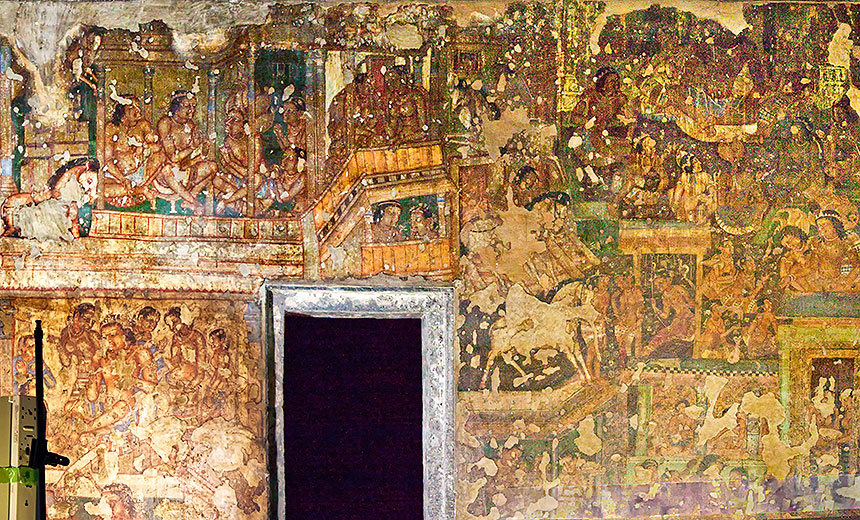
In this painting the birth of the Buddha is depicted at left of the door (sorry about the glare; we had to accept the lighting as it was). In the middle of the area to the right of the door we can see an image of Irandati, the Naga Queen, sitting on a swing (see detail below).
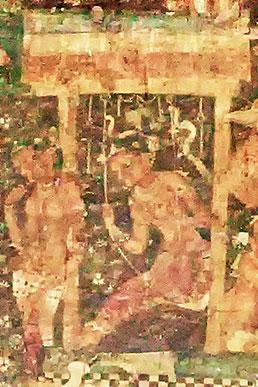
Detail of Irandati from the photo above.
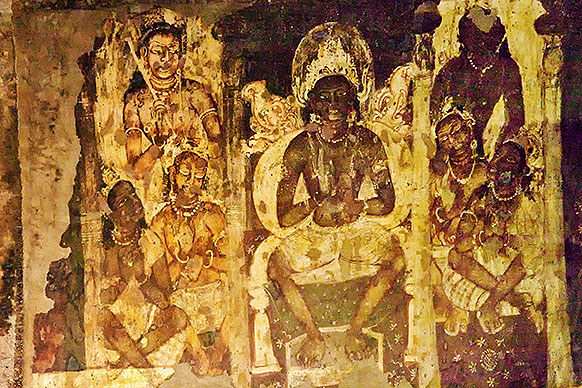
A Bodhisattva in Tusita heaven before his descent to earth.

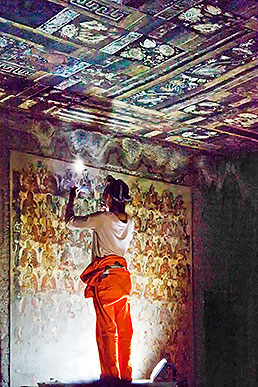
At left on this wall is the Bodhisattva seen in detail above. At right, a Japanese preservationist is working on restoration of a panel depicting the Miracle of Sravasti (the Thousand Buddhas). To confuse the heretical teachers at Sravasti, the Buddha flew into the air and manifested himself seated on a floating lotus in the middle of the room. A thousand Buddhas sprung out of his meditating body.
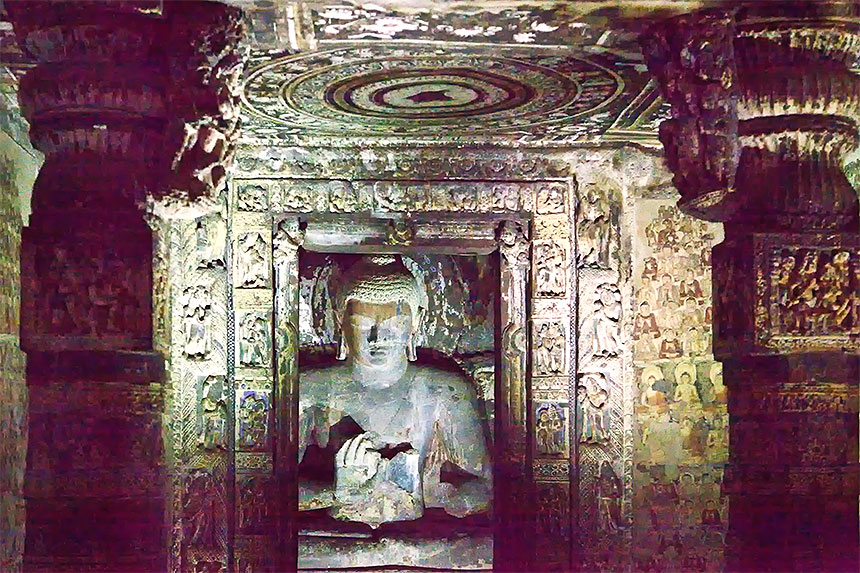
Central niche with a monumental statue of Buddha teaching. Surrounding the niche are various tempera wall and ceiling paintings. This picture illustrates the seamless integration of sculpture and painting in Cave 2.
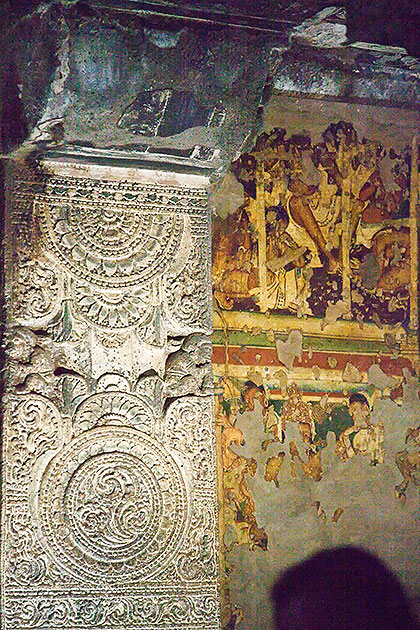
Detail of supporting pillar and tempera painting beyond.
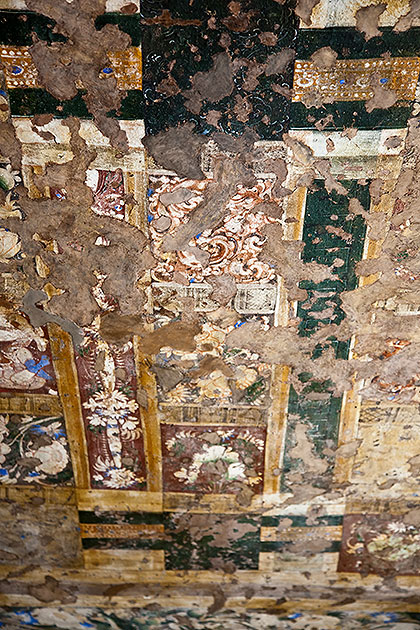
While the walls of the caves depict important tales of the Buddha, the ceilings are decorated with naturalistic images such as leaves, flowers and animals. The intense blue pigment is lapis lazuli, which is not found in India, and thus demonstrates the interconnectedness of the site with other places, as well as the richness of this place.
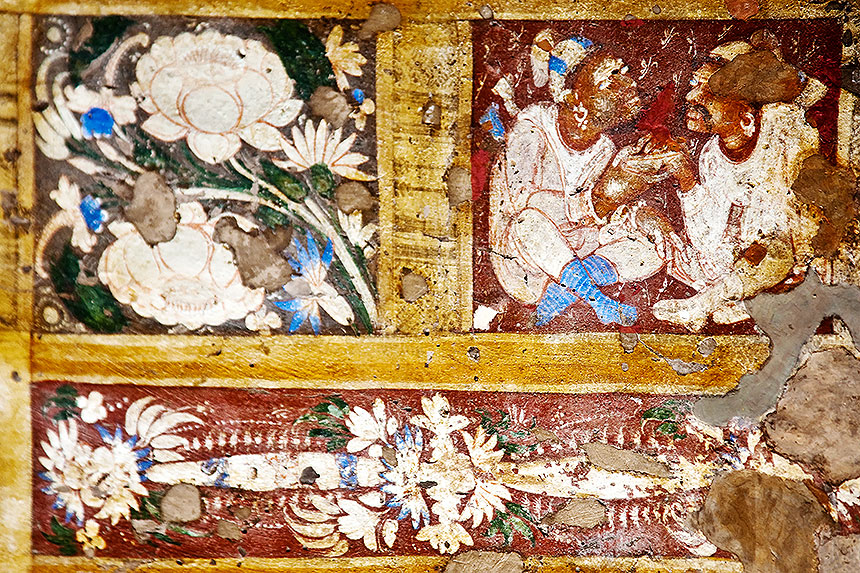
Detail of ceiling just at the left in the previous photo.


These details of ceiling and pillar are photographed in extreme darkness, so the colors are faded and not reliable.
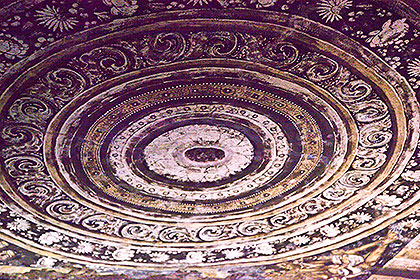
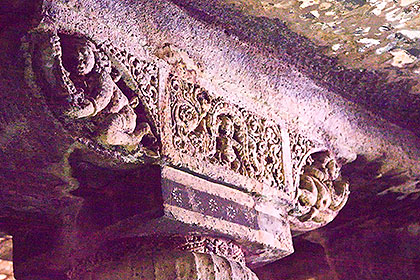
Cave 1
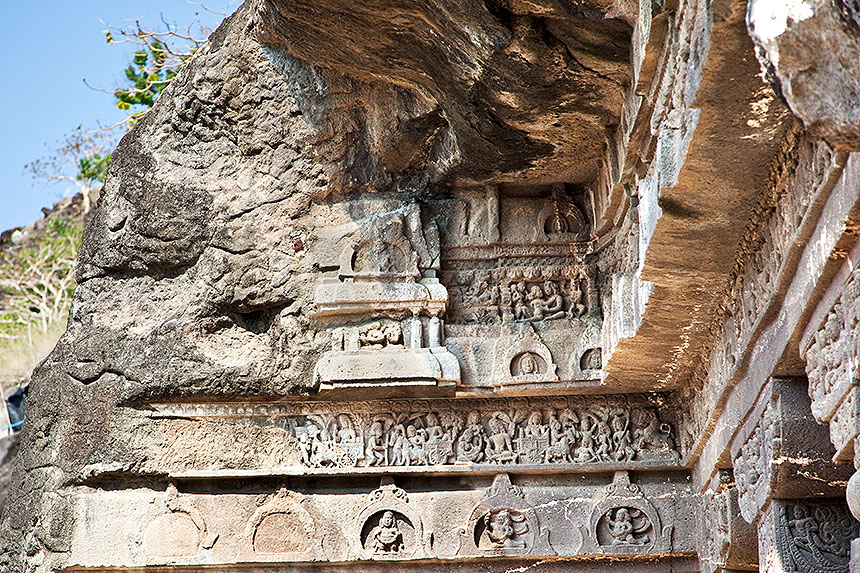
Carvings at the facade of Cave 1.

Well preserved monumental scene of the Mahajanaka Jataka. Buddha was born as a prince of Mahajanaka. The first scene, at left, depicts the prince and Princess Sivali seated in an opulent palace, but the prince has realized the futility of earthly life.

The Mahajanaka Jataka continues here with an elaborate dance arranged by the princess. But the prince is unmoved, sitting with a depressed look in the middle of the dancers. He is determined to lead an ascetic life, and attends a sermon by an ascetic in the forest, which may be depicted at right.
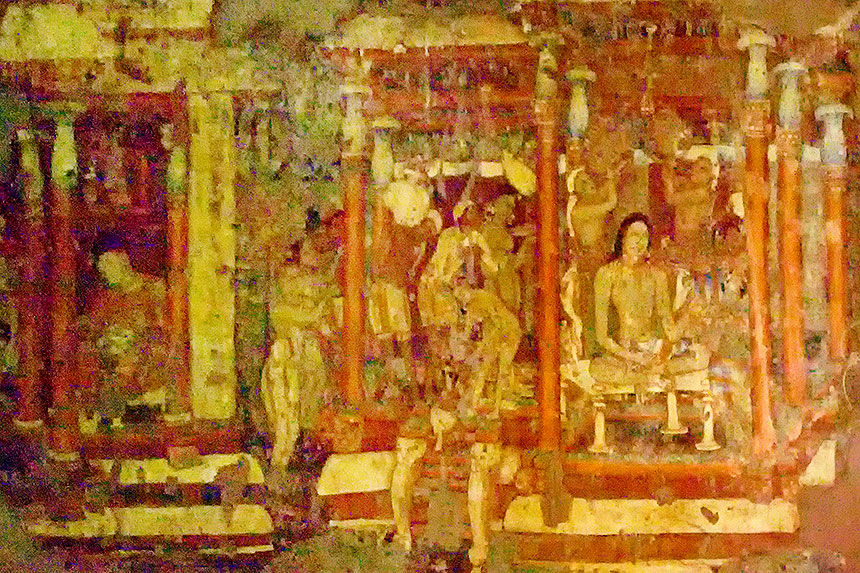
In this scene of the Mahajanaka Jataka, the prince has returned to his palace and renounced his worldly possessions. At right he takes a ritual bath before dressing as a monk.
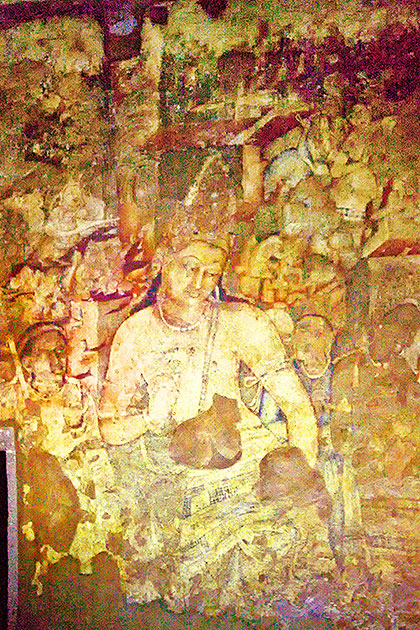
The most famous image in the Ajanta Caves, and the pride of Indian Buddhist painting, this is a portrait of the Bodhisattva Padmapani. Many art historians of India discuss how the features, coloring and physique of this Bodhissatva are perfect. This, of course, is subjective and reveals what Indian ideals of "perfection" are. Symbolically, the Bodhisattva's posture is in a typical "S" pattern, called the tribhanga (sometimes translated as "triflex"), which makes it seem as if he is dancing, but this is a common posture in Thai and Lao sculptures. Note that he is holding a lotus (padma) in his right hand, which is how he gets his name, Padmapani.
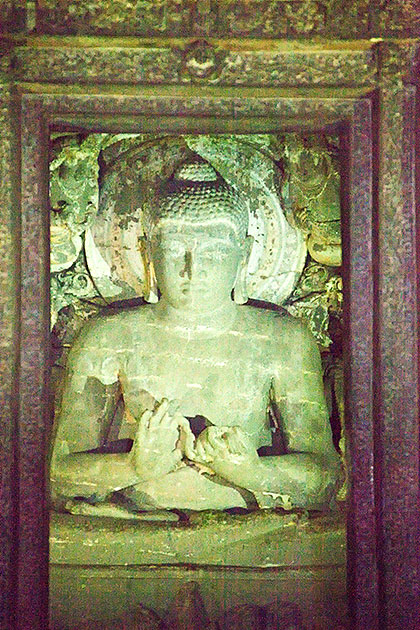
This is the Buddha in a two-handed gesture of teaching. As with the Buddha in Cave 2, his right hand creates a circle, symbolizing the Wheel of Life.

On the left side of this photo is the famous painting of the Bodhisattva Vajarapani, the most reverential bodhisattva in the Mahayana Buddhist pantheon. He is depicted as the prince of the earth and of the spiritual world, and boasts refined features, pointed nose, and an expression of peace and serenity. We are not sure, but the right side may possibly be the depiction of the Sibi Jataka, which tells of a hawk chasing a pigeon, who took refuge in the lap of the King of Sibi, a bodhisattva. The king rescued the pigeon from the hawk by offering up his body to the hawk, offering the weight of his flesh equal to the weight of the bird, which revealed his unbounded charitable spirit. This is an example of what a bodhisattva is in Buddhism: a saint-like person who has gained enlightenment but defers achieving Nirvana -- the exit from samsara -- to remain to help others.
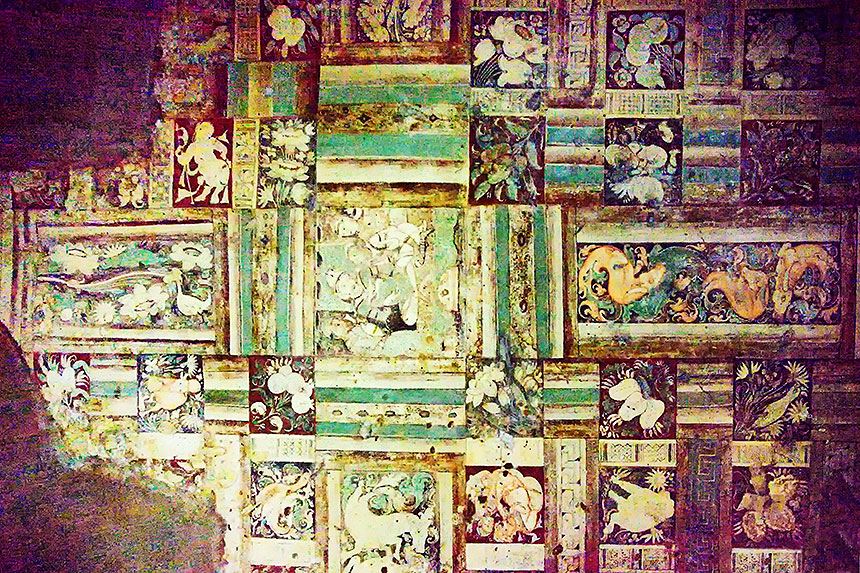
Section of ceiling, with naturalistic images. There are some human figures as well as animals and plants this time.
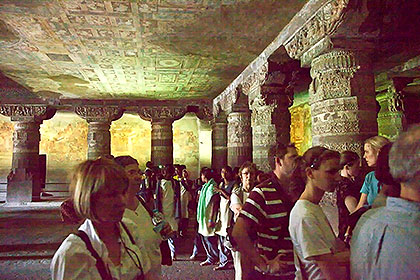
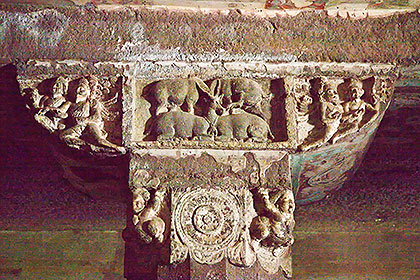
Left, a view of the figured ceiling and many pillars inside the cave, as well as some tourists (including us). Right, detail of a pillar cap.
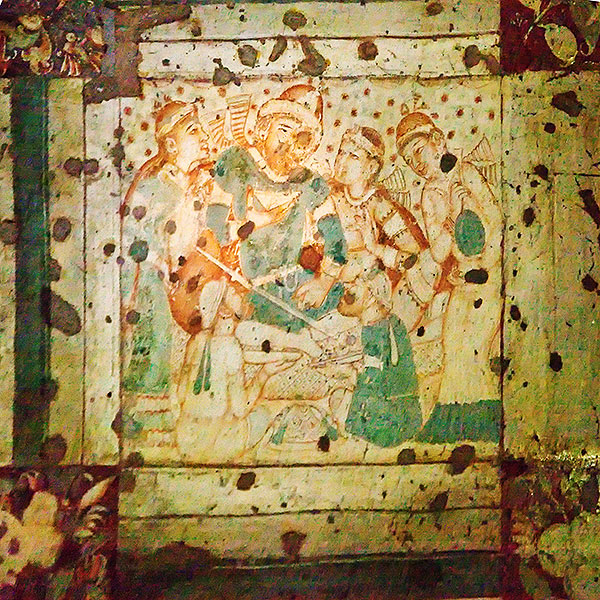
Detail of one ceiling scene.
Cave 10
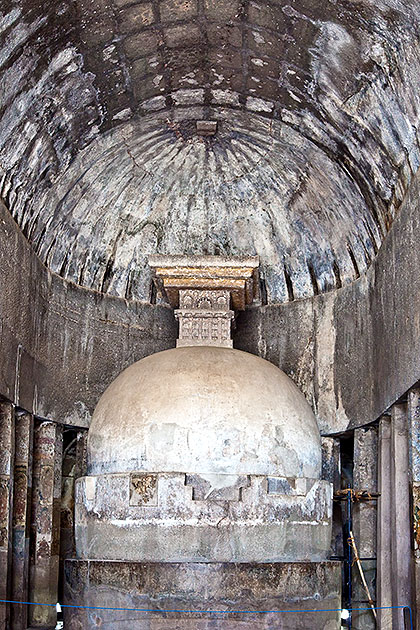
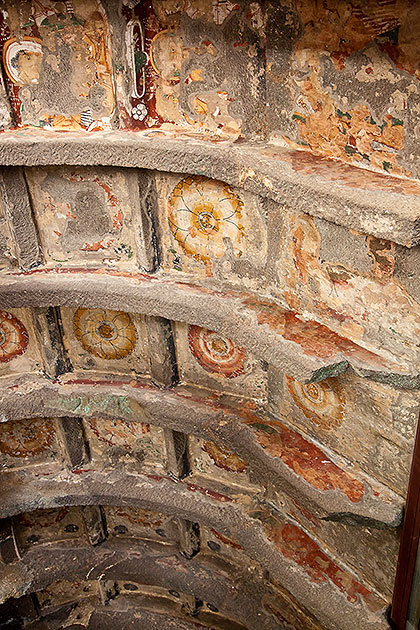
Cave 10 is the oldest of the Hinyana Chaitya ("cathedral") caves, and it was the first to be "discovered" by the British in 1819, for it is the tallest (and thus most easily spotted). Dating from 200 BC, the symbolic representation of the Buddha (left) as a chedi (mound-like-stupa) predates the more literal depictions. Right: the vaulted ceiling of a side gallery.

A side gallery. The paintings of bodhisattvas were likely later additions. Below: details of images on side columns.
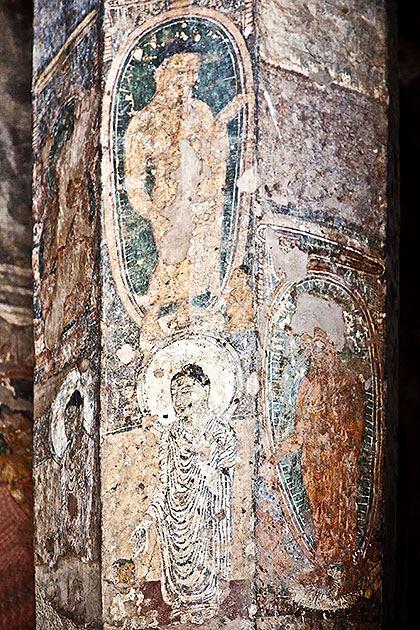
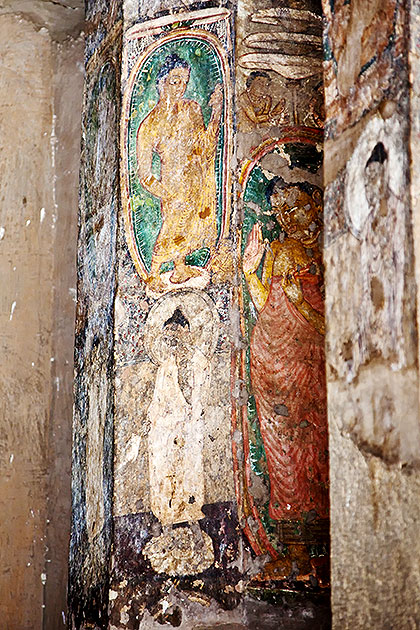
Cave 17
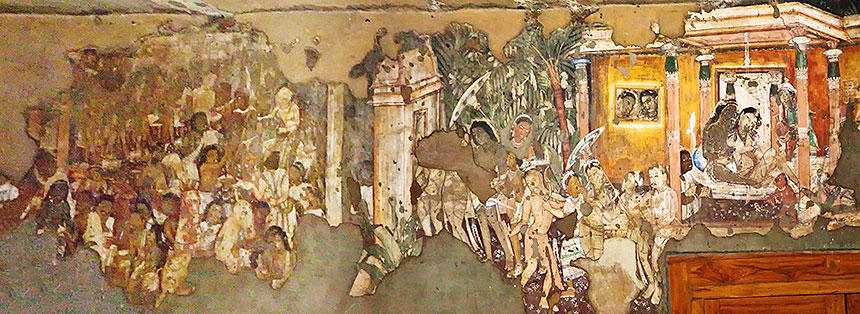
A panel from the Visvantara Jataka. At right, Prince Visvantara tells Princess Madri that he has been banished from his kingdom for "excessive" generosity, perceived as unwise by all. He gave away his most precious elephant to a jealous king, showing his interest in dharma was greater than politics. More of the panel appears in the photo below, but it is badly damaged..
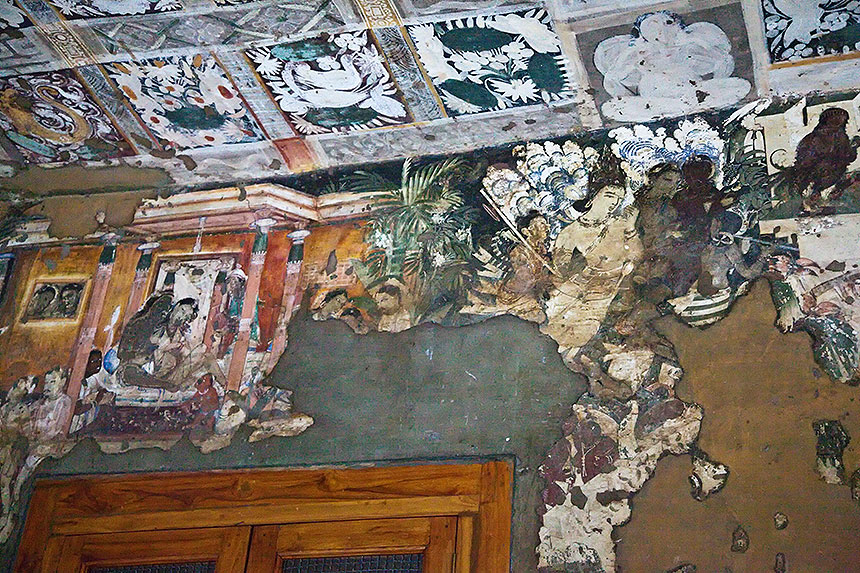

This scene may also be part of the Visvantara Jakata sequence, or it may belong to another story. We are not sure.
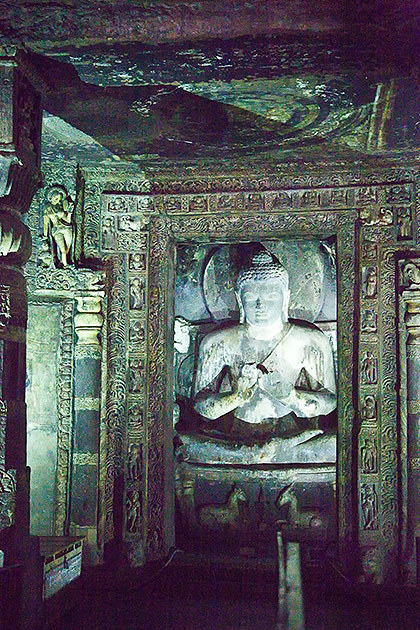
Another teaching Buddha in this cave.
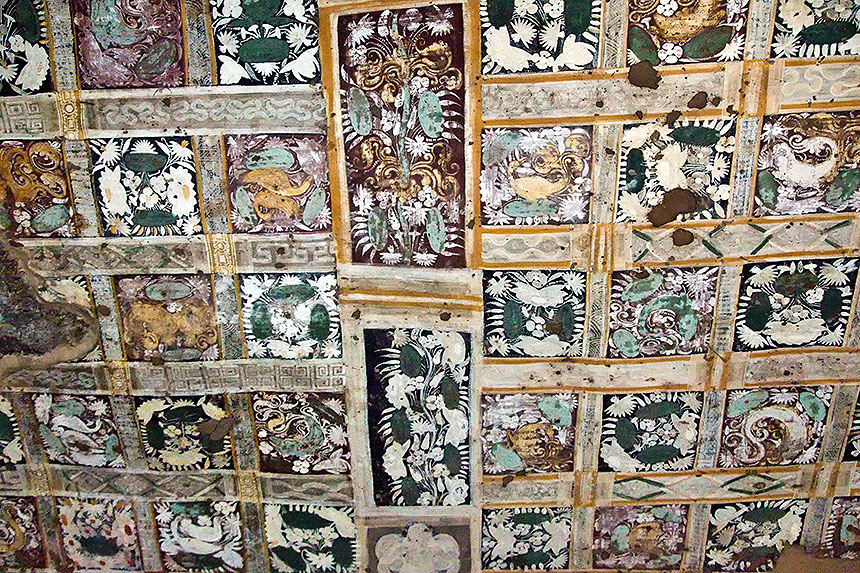
Above and below: ceiling details.
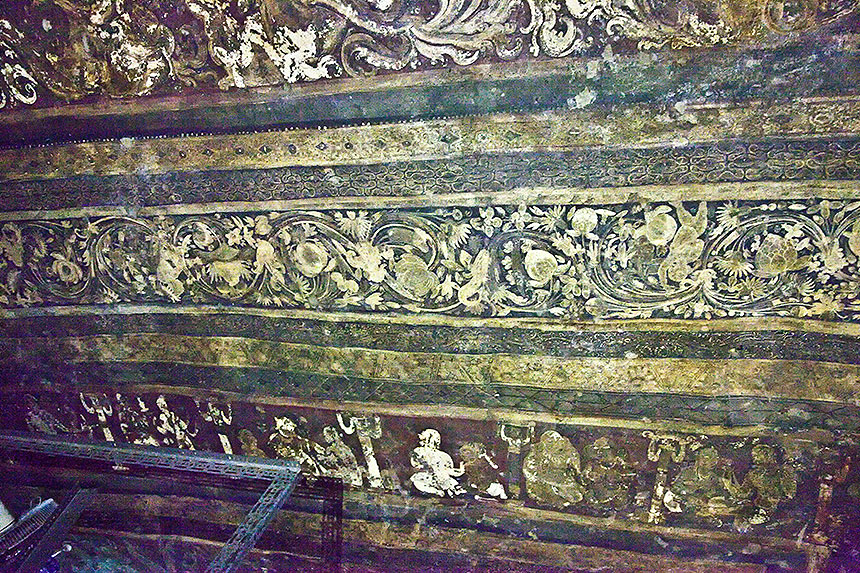

A very erudite local subject matter expert explains the Ajanta Cave art to us, but we find it difficult to absorb and remember so much.
Cave 19
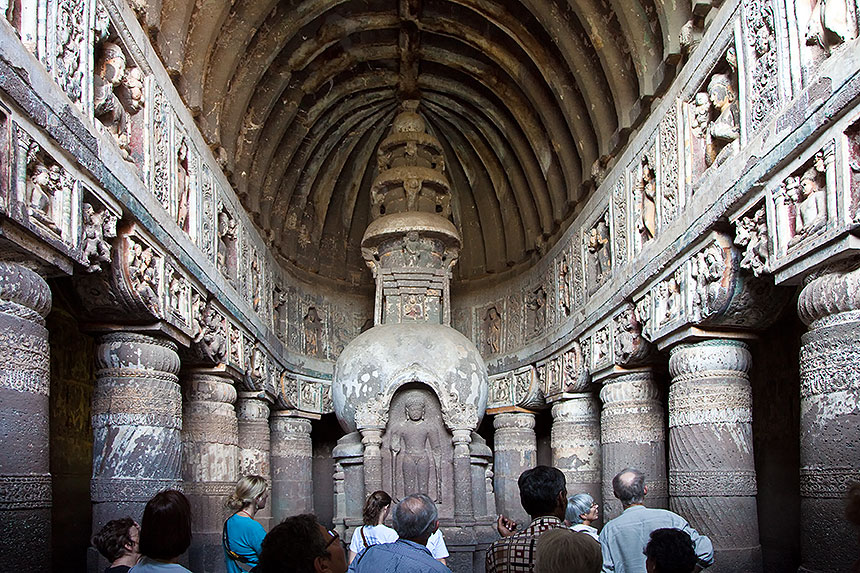
Dating from 600AD, this small chaitya (cathedral) cave is known as one of the best examples of Buddhist rock-cut architecture. Compare the interior of other caves with plain squarish pillars to this one with tapered, detailed, lotus-shaped pillars. The chedi in the middle reflects a gradual transformation away from the symbolic into more literal images of the Buddha. Here, the Buddha is carved into the chedi. The photo below shows more detail of the features making Cave 19 so exceptional.

Cave 24

As our group collects in front of Cave 24 we take a moment to look back at some of the caves we have already visited or passed by. Use the slider to pan across the panorama to see the facades of caves in the range of 23 to approximately 15, following the horseshoe bend of the river.
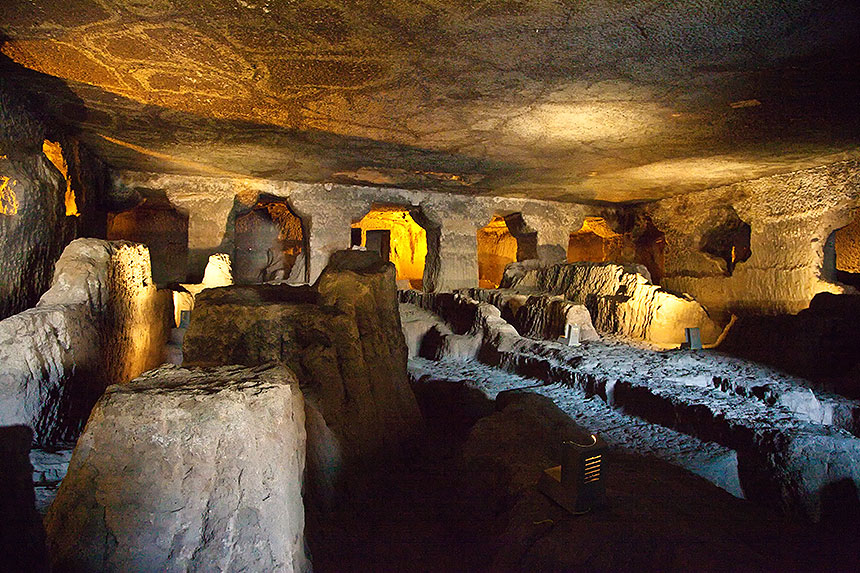
Cave 24 was started, but never finished. It shows the technique of the rock carvers -- excavating the interior, working from top to bottom, leaving pillars in place to be further sculpted with decorations later.
Cave 26

We now enter Cave 26, the last one we will be visiting. Dating 25 years later than Cave 19, the interior is larger, and the "hybrid" chedi sculpture is more elaborate. Warm incandescent lighting in the side galleries lends golden highlights to the chaitya here. We think the incandescent lighting may have been added more recently than original completion of the cave around 625 AD.
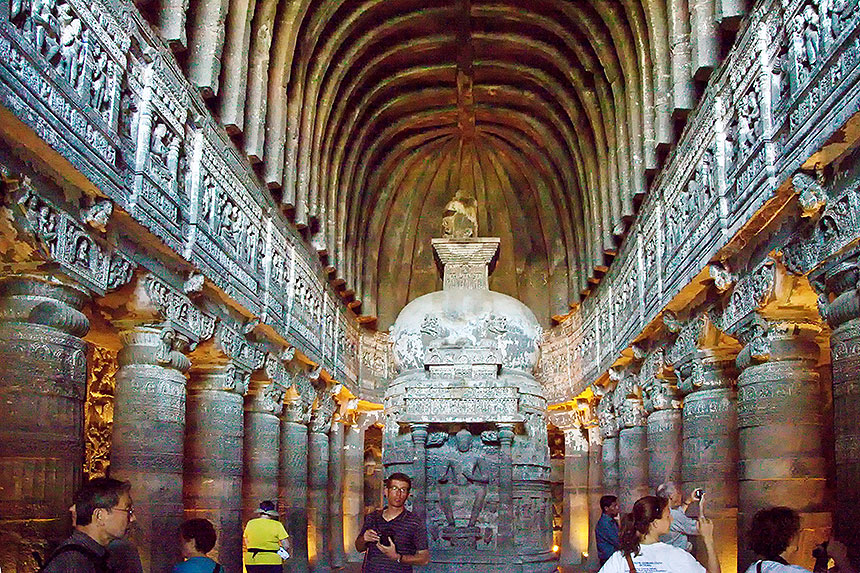


Monumental sculpture (seen here in two pieces) of the reclining Buddha, often known as the Parinirvana Buddha. It depicts the Buddha at the moment of death -- the moment he reaches the last stage of nirvana (pari-nirvana), or liberation (moksha) from the cycle of rebirth (samsara).

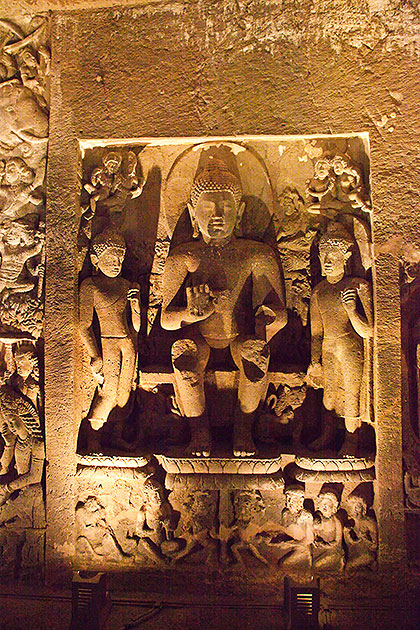
While the cave paintings in this cave have not survived, these bas reliefs have. They depict other moments in the Buddha's life. Above left, the Buddha, who is seated in the lotus position, is making the varada gesture, or the gesture of compassion ("conferring a boon") -- the right arm is extended all the way down with palm facing outwards. Though partly damaged, the other bas reliefs show the Buddha teaching his disciples. Like the central Buddhas carved into some of the chedis, note that he is seated "European style", as some Indian art historians put it.
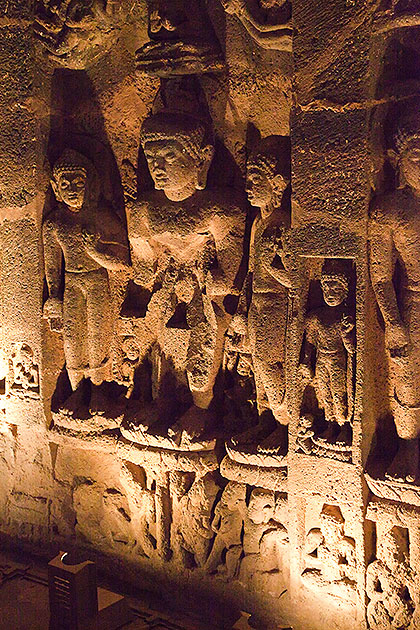
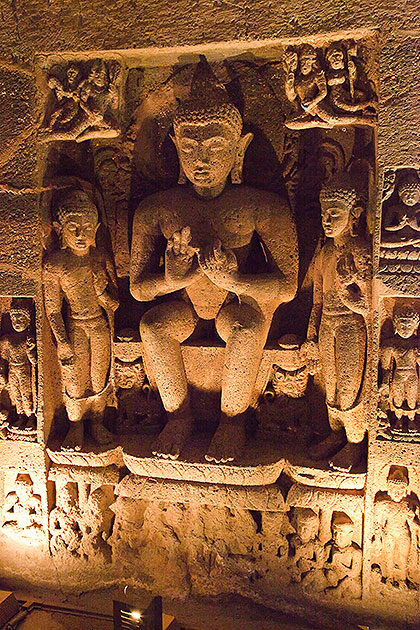
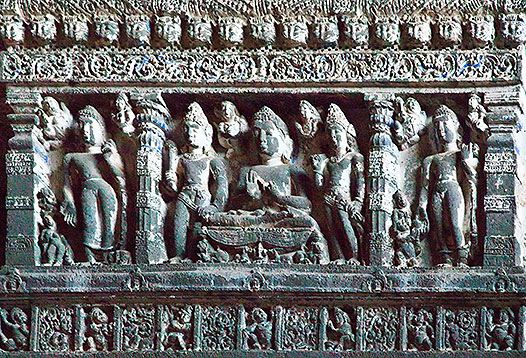
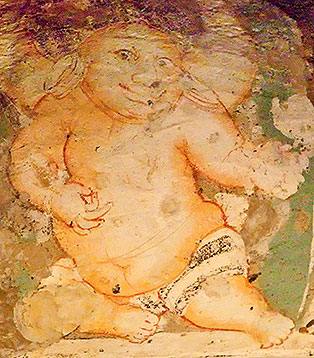
Finally, we see a detail from the side wall just beneath the ceiling, and another detail from a side gallery ceiling.
With this we conclude our visit to the Ajanta Caves and return to Aurangabad. Tomorrow morning we will fly to Udaipur.